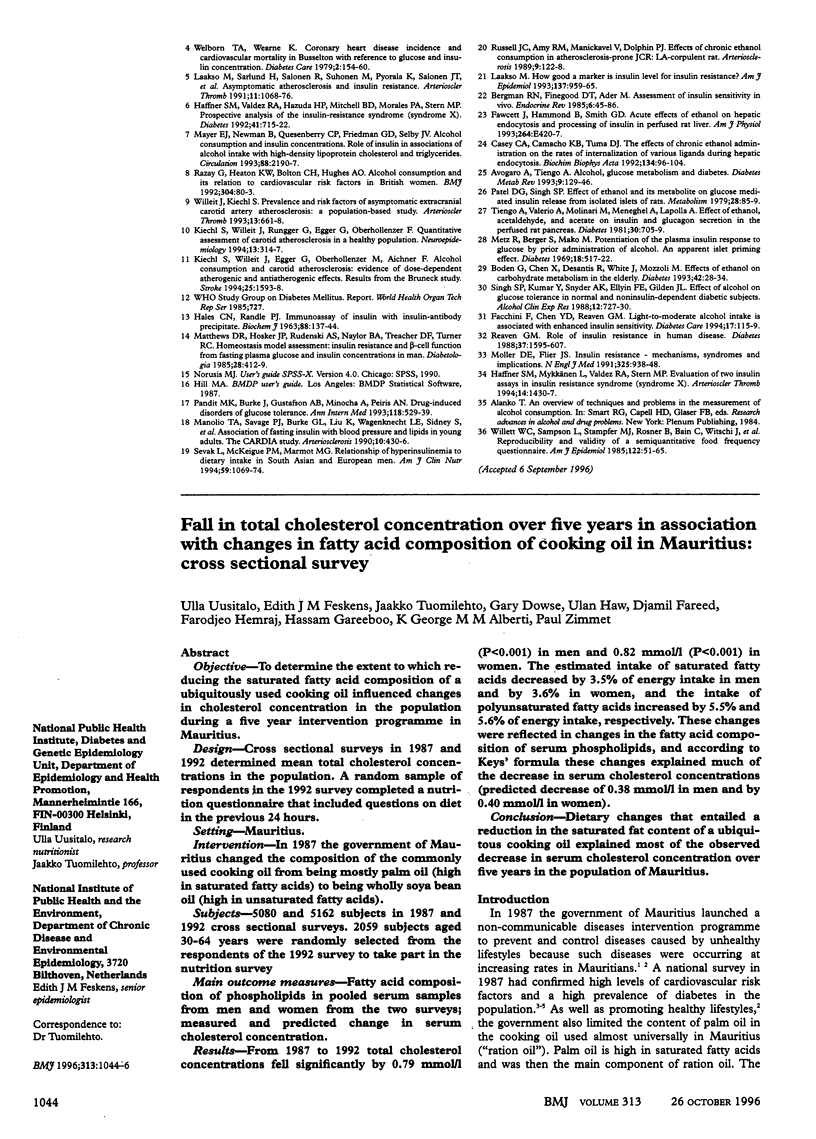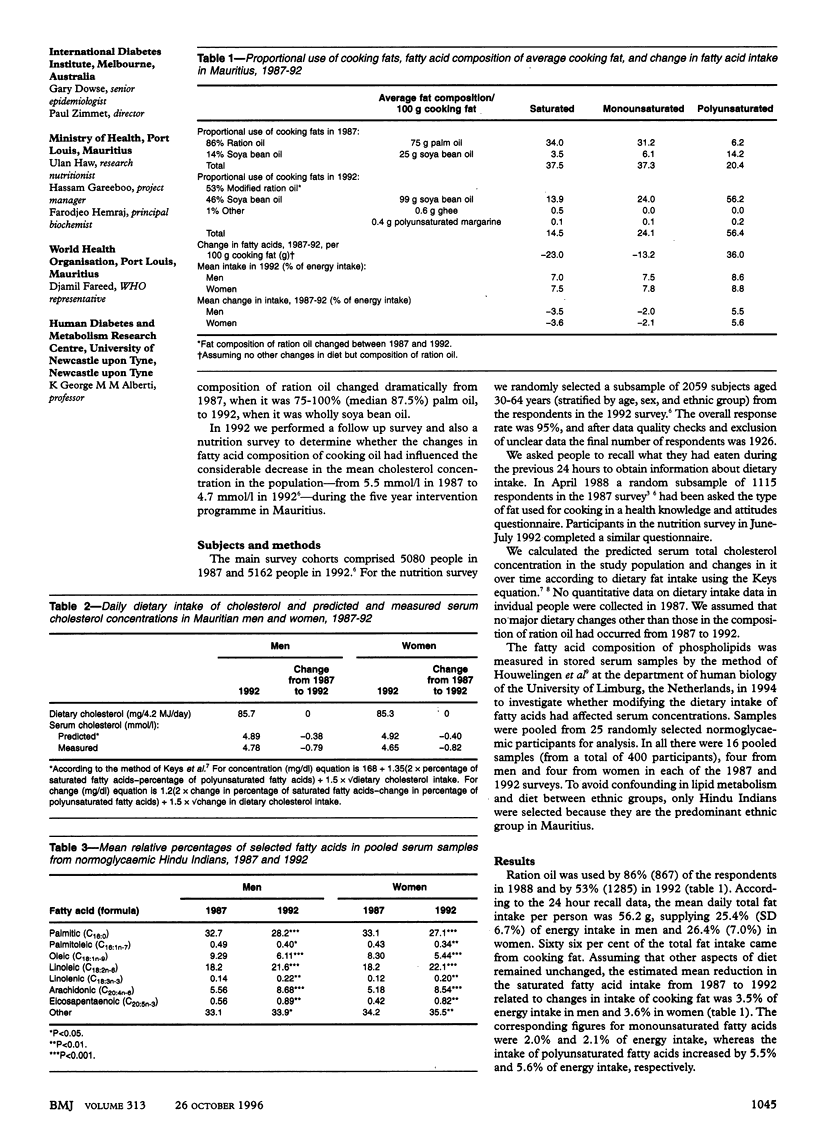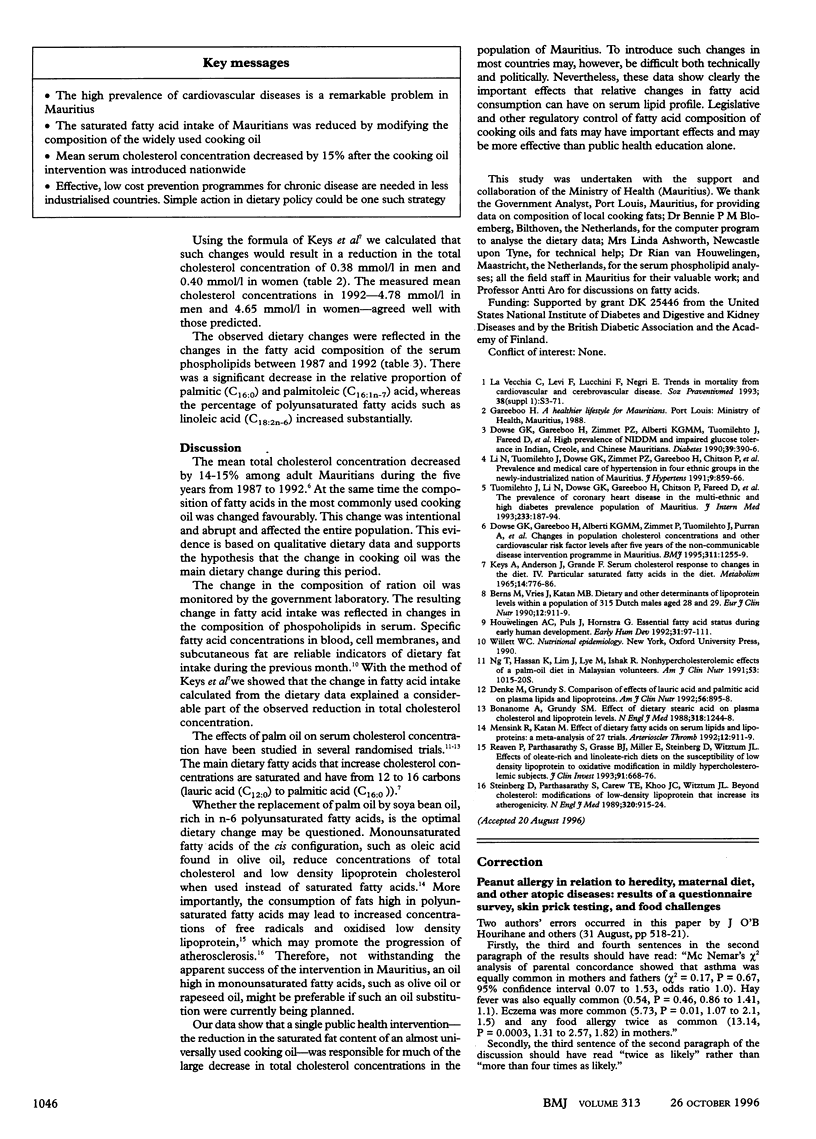Abstract
OBJECTIVE: To determine the extent to which reducing the saturated fatty acid composition of a ubiquitously used cooking oil influenced changes in cholesterol concentration in the population during a five year intervention programme in Mauritius. DESIGN: Cross sectional surveys in 1987 and 1992 determined mean total cholesterol concentrations in the population. A random sample of respondents in the 1992 survey completed a nutrition questionnaire that included questions on diet in the previous 24 hours. SETTING: Mauritius. INTERVENTION: In 1987 the government of Mauritius changed the composition of the commonly used cooking oil from being mostly palm oil (high in saturated fatty acids) to being wholly soya bean oil (high in unsaturated fatty acids). SUBJECTS: 5080 and 5162 subjects in 1987 and 1992 cross sectional surveys. 2059 subjects aged 30-64 years were randomly selected from the respondents of the 1992 survey to take part in the nutrition survey. MAIN OUTCOME MEASURES: Fatty acid composition of phospholipids in pooled serum samples from men and women from the two surveys; measured and predicted change in serum cholesterol concentration. RESULTS: From 1987 to 1992 total cholesterol concentrations fell significantly by 0.79 mmol/l (P < 0.001) in men and 0.82 mmol/l (P < 0.001) in women. The estimated intake of saturated fatty acids decreased by 3.5% of energy intake in men and by 3.6% in women, and the intake of polyunsaturated fatty acids increased by 5.5% and 5.6% of energy intake, respectively. These changes were reflected in changes in the fatty acid composition of serum phospholipids, and according to Keys' formula these changes explained much of the decrease in serum cholesterol concentrations (predicted decrease of 0.38 mmol/l in men and by 0.40 mmol/l in women). CONCLUSION: Dietary changes that entailed a reduction in the saturated fat content of a ubiquitous cooking oil explained most of the observed decrease in serum cholesterol concentration over five years in the population of Mauritius.
Full text
PDF


Selected References
These references are in PubMed. This may not be the complete list of references from this article.
- Bonanome A., Grundy S. M. Effect of dietary stearic acid on plasma cholesterol and lipoprotein levels. N Engl J Med. 1988 May 12;318(19):1244–1248. doi: 10.1056/NEJM198805123181905. [DOI] [PubMed] [Google Scholar]
- Denke M. A., Grundy S. M. Comparison of effects of lauric acid and palmitic acid on plasma lipids and lipoproteins. Am J Clin Nutr. 1992 Nov;56(5):895–898. doi: 10.1093/ajcn/56.5.895. [DOI] [PubMed] [Google Scholar]
- Dowse G. K., Gareeboo H., Alberti K. G., Zimmet P., Tuomilehto J., Purran A., Fareed D., Chitson P., Collins V. R. Changes in population cholesterol concentrations and other cardiovascular risk factor levels after five years of the non-communicable disease intervention programme in Mauritius. Mauritius Non-communicable Disease Study Group. BMJ. 1995 Nov 11;311(7015):1255–1259. doi: 10.1136/bmj.311.7015.1255. [DOI] [PMC free article] [PubMed] [Google Scholar]
- Dowse G. K., Gareeboo H., Zimmet P. Z., Alberti K. G., Tuomilehto J., Fareed D., Brissonnette L. G., Finch C. F. High prevalence of NIDDM and impaired glucose tolerance in Indian, Creole, and Chinese Mauritians. Mauritius Noncommunicable Disease Study Group. Diabetes. 1990 Mar;39(3):390–396. doi: 10.2337/diab.39.3.390. [DOI] [PubMed] [Google Scholar]
- Mensink R. P., Katan M. B. Effect of dietary fatty acids on serum lipids and lipoproteins. A meta-analysis of 27 trials. Arterioscler Thromb. 1992 Aug;12(8):911–919. doi: 10.1161/01.atv.12.8.911. [DOI] [PubMed] [Google Scholar]
- Nan L., Tuomilehto J., Dowse G., Zimmet P., Gareeboo H., Chitson P., Korhonen H. J., Alberti K. G., Fareed D. Prevalence and medical care of hypertension in four ethnic groups in the newly-industrialized nation of Mauritius. J Hypertens. 1991 Sep;9(9):859–866. doi: 10.1097/00004872-199109000-00014. [DOI] [PubMed] [Google Scholar]
- Reaven P., Parthasarathy S., Grasse B. J., Miller E., Steinberg D., Witztum J. L. Effects of oleate-rich and linoleate-rich diets on the susceptibility of low density lipoprotein to oxidative modification in mildly hypercholesterolemic subjects. J Clin Invest. 1993 Feb;91(2):668–676. doi: 10.1172/JCI116247. [DOI] [PMC free article] [PubMed] [Google Scholar]
- Steinberg D., Parthasarathy S., Carew T. E., Khoo J. C., Witztum J. L. Beyond cholesterol. Modifications of low-density lipoprotein that increase its atherogenicity. N Engl J Med. 1989 Apr 6;320(14):915–924. doi: 10.1056/NEJM198904063201407. [DOI] [PubMed] [Google Scholar]
- Tuomilehto J., Li N., Dowse G., Gareeboo H., Chitson P., Fareed D., Min Z., Alberti K. G., Zimmet P. The prevalence of coronary heart disease in the multi-ethnic and high diabetes prevalence population of Mauritius. J Intern Med. 1993 Feb;233(2):187–194. doi: 10.1111/j.1365-2796.1993.tb00672.x. [DOI] [PubMed] [Google Scholar]
- van Houwelingen A. C., Puls J., Hornstra G. Essential fatty acid status during early human development. Early Hum Dev. 1992 Dec;31(2):97–111. doi: 10.1016/0378-3782(92)90038-i. [DOI] [PubMed] [Google Scholar]


